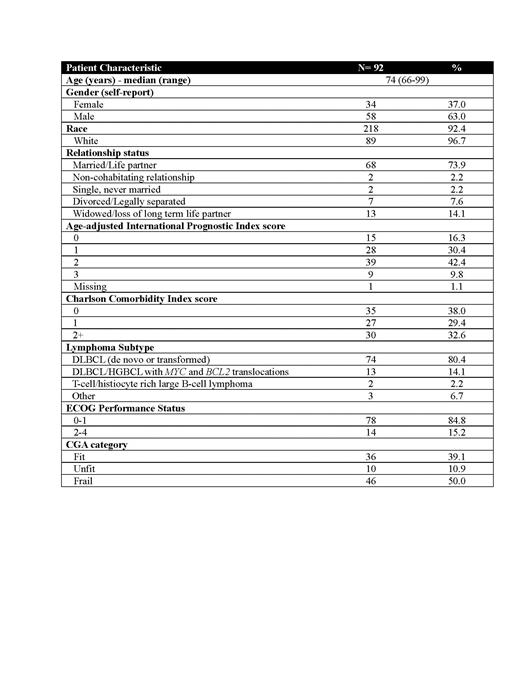Background: Diffuse large B cell lymphoma (DLBCL) is an aggressive lymphoid malignancy that often affects older adults. Therapy is potentially curative, with up to two-thirds of patients cured with chemoimmunotherapy but carries substantial risk of toxicity. Treatment of older adults must balance the potential for cure with the risk of therapy toxicity and intensive healthcare utilization. Therefore, prognostic understanding is a crucial component of informed decision-making for this patient population. Yet, data regarding prognostic understanding in older adults with DLBCL are lacking.
Methods: We conducted a prospective study of older adults with aggressive non-Hodgkin lymphomas at two tertiary care hospitals between 9/2020 and 01/2023. Eligible patients were age >= 65 years at time of treatment initiation receiving a combination chemoimmunotherapy. Patients could enroll up until cycle 1 day 8 of therapy. Patients completed questionnaires at baseline that assessed demographics as well as information preferences and prognostic understanding (Prognosis and Treatment Perception Questionnaire) and underwent a comprehensive geriatric assessment. We used descriptive statistics to examine patient beliefs regarding likelihood of cure, the importance of knowing about prognosis, and preferences for information about treatment at baseline. We focused on the subset of patients (N=92) with DLBCL or DLBCL/high grade B-cell lymphoma with MYC and BCL2 translocations (double hit lymphoma) in order to have a relatively homogenous population for prognosis and likelihood of cure.
Results: The parent study enrolled 106/163 (65.0%) patients, with 92 patients having DLBCL or double hit lymphoma. 88/92 enrolled patients with DLBCL (95.7%) submitted the prognostic understanding questionnaire. Among DLBCL/double hit lymphoma patients (N=92), the median age was 74 years (range: 66-99), and most were male gender (63%), White race (96.7%), and married/with a life partner (73.9%). 48/91 (52.7%) had an age-adjusted International Prognostic Index of 2 or 3, 30/92 (32.6%) had a Charlson comorbidity index of 2+ (not counting the patients' lymphoma), 14/92 (15.2%) had an Eastern Cooperative Group performance status of 2-4, and 50% (46/92) were frail based on comprehensive geriatric assessment. When asked about their likelihood of cure, 37.5% (33/88) selected >90% chance, 37.5% (33/88) selected 75-90% chance, 20.5% (18/88) selected 50-74% chance, 3.4% (3/88) selected 25-49% chance, and 1.1% (1/88) selected 10-24% chance of cure. Most (88.6%;78/88) patients believed that the primary goal of their current treatment was to cure their cancer, and most (93%; 80/86) believed that was their oncologist's primary goal. When asked if they would prefer a course of treatment focused on extending life as much as possible even if it meant more pain and discomfort versus a plan of care focused on relieving pain and discomfort as much as possible, even if it meant not living as long, 30.0% (26/88) chose extending life as much as possible, 40.9% (36/88) chose relieving pain as much as possible, and 30.0% (26/88) did not know. 94.0% (78/83) reported that they had a conversation about prognosis with their oncologist. The majority (91%; 78/86) felt it was extremely important or very important to know about their prognosis over time, and felt (81.4%; 70/86) they had just the right amount of information about their prognosis. Patients stated that knowing about their prognosis was extremely helpful in making decisions about treatment (75.3%; 61/81), preparing for the future (68.3%; 56/82), maintaining hope (79.3%; 65/82), and coping with the disease (72.5%; 58/80). 74.4% (61/82) said that overall knowing about prognosis was extremely helpful.
Conclusion: In this cohort of older adults receiving treatment for DLBCL or double hit lymphoma, the vast majority felt it was important to know prognostic information over time and found that this information was helpful for decision making. Our finding that the majority estimated their likelihood of cure to exceed 75% despite most having aa-IPI scores indicating average cure rates < 60 suggests that older adults with newly diagnosed DLBCL hold overly optimistic views of their prognosis.
Disclosures
El-Jawahri:Novartis: Consultancy; Incyte Corporation: Consultancy; GSK: Consultancy. Johnson:Seagen: Consultancy; AstraZeneca: Consultancy, Research Funding; ADC Therapeutics: Consultancy; Incyte: Consultancy, Research Funding; Abbvie: Consultancy; Medically Home: Research Funding.


This feature is available to Subscribers Only
Sign In or Create an Account Close Modal